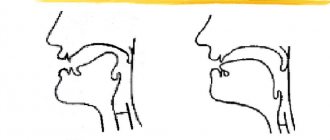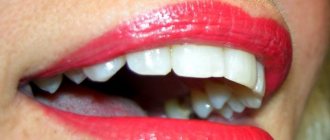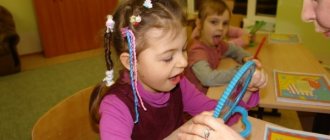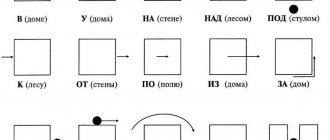History of the origin of the letter L
In ancient times, the letter L had a different name. Now we call it -el-, but once it was “people”. The letter had a strange name, didn’t it?
She also appeared in a strange way.
In those distant times there was a word meaning “man.” This word was pronounced “lyudin”. The root of that word is still alive today in the word “commoner.”
There was even a settlement in the Kaluga region called Lyudinovo. The name of the town was given for its large population.
"Lyud" from Indo-European means "to grow." If we somehow connect this with a person, then we can say that a person, a human being, is the one who grows.
In Rus', the letter L was associated with such beautiful words as: love, affection.
The most beautiful name is for the letter L -El- in the Cyrillic alphabet. In Phoenician it is “lamed”, and in the Greek alphabet it is generally “lambda”. According to some information, it was from the Greek lambda that the letter L, which today occupies a place in the Russian alphabet, originated.
We can compare and understand that they are indeed very similar: our L and the Greek lambda Λ, λ.
What is lambdacism and its varieties
Lambdaism is usually called the incorrect pronunciation of the sound L or its complete loss in speech.
There are several types of this violation:
- Nasal - when you exhale, the air flows through the nose. The reason for this pronunciation is that the soft palate is in contact with the root of the tongue. Instead of "lamp" it becomes "ngampa".
- Bilabial - when pronouncing, the labial muscles tense; instead of the desired sound, the child pronounces “u” - “uapata” instead of the word “shovel”.
- Interdental - the tip of the tongue falls out between the teeth.
- Lower - the tongue rests on the lower teeth. This variety is the most difficult to correct.
- Fricative - instead of the desired sound, a softened (“Ukrainian”) G is obtained.
Replacing the sound L with others is called paralambdacism.
The most common types of replacement:
- B - “vuk” instead of “bow”;
- D - “dozhka” instead of spoon;
- Y - “yampa” instead of “lamp”;
- soft L - “plait” instead of “raft”.
Some children experience a complete loss of the L sound. Instead of the word “fox,” they pronounce “isa.”
What are the reasons for the incorrect pronunciation of L?
Until the age of 4, the speech apparatus is not adapted to pronouncing this sound, so lambdaism at this age is considered a variant of the norm.
There are several reasons why a child speaks incorrectly:
- Improper breathing during speech.
- Disturbances in the development of speech hearing - the child has difficulty hearing the speech of other people and does not perceive meaning well.
- Insufficient development of the articulatory apparatus, weakness of facial muscles and tongue. These muscles play a leading role in the pronunciation of sounds.
- Deviations in the structure of the hyoid ligament (frenulum) - speech disorders are possible if the ligament is short.
Improper breathing can be due to several factors:
- The child's lung capacity is reduced.
- The respiratory muscles are weak, so the child cannot speak loudly.
- When exhaling, the air stream comes out in jerks, so it becomes difficult to finish a long sentence.
- Incorrect distribution of air, resulting in inhalation starting in the middle of the word.
What mistakes can there be when trying to pronounce L?
If a child tries to pronounce the sound L, the following errors are possible:
- The tongue goes deep into the oral cavity, its tip does not come into contact with the upper teeth or gums. Instead of the desired sound, the child produces Y (“boat” - “yodka”).
- A sharp breath at the moment when you need to say the right sound. If the muscles of the cheeks are involved in the process, the phoneme F is obtained.
- The air flow passes into the nose, so it turns out to be N.
Sometimes the child is first given R and then L. In such a situation, the second sound can replace the first (“rune” instead of “moon”)
How to make the sound L
After completing the preparatory stage, they move on to the main exercises.
Staging L is carried out:
- by imitation;
- on inspiration;
- by mechanical means.
When the child begins to pronounce the letter correctly, it is necessary to consolidate this skill and bring it to automaticity. First, the child needs to be taught a soft sound, then a hard one.
By imitation
The most common method of learning is through imitation of an adult. First, the parent or speech therapist shows how to properly position the tongue and lips.
To make it clearer to the child, you can first explain to him in words:
- The language needs to be made broad.
- The tip is pressed against the upper front teeth or gums.
- The middle of the tongue is bent downwards, and the root is raised.
- Do not raise the side parts so that air can pass between them and the cheeks.
To check for correctness, touch the cheeks while the child says L. If everything is done correctly, the cheek muscles vibrate slightly.
It is better to practice in front of a mirror. First, the adult says it correctly himself several times, then asks the child to repeat it.
Automation of the sound “L” in phrases.
On inspiration
Exercises to develop correct articulation are combined with breathing exercises. It is advisable to put L while inhaling.
Before starting the workout, do several breathing movements:
- Inhale quickly - 1 second.
- Exhale smoothly and slowly - up to 5 seconds.
Then you can complicate the exercise and present it in the form of a game. The ratio of inhalation and exhalation should be maintained.
The complex for each child is selected individually and may include the following exercises:
- Blow on the pinwheel and watch it spin.
- "Stop a running horse." Inhale, lips relax. The air is exhaled to make a “prrrrr” sound.
- The child lies on his back on a flat surface (floor or hard couch). The hand is placed on the stomach. Inhale and inflate your stomach. The hand should feel how, as you inhale, “the ball inflates”, and as you exhale, it “deflates.”
- You can ask your child to close his eyes and guess the smell of fruits or other objects. As you inhale, you need to smell the fruit, drawing in air through your nose. As you exhale, pronounce the name of the object.
With mechanical assistance
To set the sound correctly, you can use mechanical devices:
- spatula;
- special probes;
- wooden ice cream stick;
- handle of a spoon, etc.
If there are no suitable objects at home, you can help the child with your fingers. The main task of such work is to fix the organ or muscle in the correct position.
Using improvised means, do the following exercises:
- A wooden stick is placed across the tongue. In this way, space is created between the upper molars and the sides of the tongue. The correct passage of air through the oral cavity is formed.
- Setting a hard sound from a soft one is done using the thumb. To do this, place the fingertip in the hollow under the chin. Lightly press on this area, and the sound reflexively becomes hard.
- You can learn to pronounce a hard phoneme by pressing the back of your hand to the bottom of your chin.
- If the child is overly tense, you can relax the facial muscles a little by massaging them with your fingertips.
- To correct bilabial lambdacism, the corners of the lips are stretched to a smile position and held in this state with the index fingers.
You can relieve tension by smacking your lips, exhaling through your mouth full through closed teeth - “oof”, snorting.
Words for practicing the sound “L”.
The process of working on sound [L]
If the pronunciation of several phonemes is defective, as well as if speech disorders occur in adulthood after suffering stress or injury, it is necessary to seek qualified help from a speech therapist. If an adult pronounces only one or two phonemes incorrectly, he can cope with the speech problem on his own at home, without the help of a specialist.
The process of eliminating defective pronunciation of any sound consists of four stages: preparatory, production itself, automation, differentiation.
You cannot skip a stage and move on to the next one without completely mastering the previous one.
Preparatory exercises for sound [L]
The preparatory stage serves to create the correct articulatory position. It involves performing special speech therapy exercises. To correctly reproduce the sound [L], it is important to raise the tip and back of the tongue, learn to relax the lateral edges and make a targeted exhalation.
To practice lifting the tip of the tongue, the following exercises are used:
- Open your mouth, lips are not tense, a relaxed tongue is quickly placed first on the upper lip, then on the lower. Gradually complicate the action by moving the tongue into the mouth, fixing it at the alveolar processes.
- Open your mouth. Using a flat tongue, lick the relaxed upper lip, moving from top to bottom, then hide the tongue towards the middle of the palate.
- Smile and open your mouth. Press your flat tongue against the upper alveoli and loudly tear away. Start slowly, gradually accelerating.
- Smile with your mouth open. Use the flattened edge of your tongue to slap your upper lip back and forth, trying not to separate your tongue from your lip. Start performing actions slowly, gradually pick up speed and connect the vocal cords, achieving the combination [Bl-bl].
- Tighten the bent tip of your tongue and move it back and forth across the palate at different speeds. The interdental space is equal to the thickness of a finger. The lips open slightly and do not touch the incisors. The jaws are static.
Raising the back of the lingual back is practiced by singing the vowel phonemes [O], [U], [A], [Y]. To train the skill of lowering the sides of the tongue and purposefully exhaling a stream through the gap between them and the molars, you need to tightly hold the flat tip of the tongue with your teeth, exhale air, puffing out your cheeks, and at the same time lightly tap them with your fingers to make a squelching sound.
When the articulatory organs are ready and the exercises can be performed flawlessly, at a fairly rhythmic pace, you can start setting up the sound.
Methods for producing the sound [L] in adults
The production of the [L] sound in adults is carried out using the same methods as in children; the choice of technique depends on the mechanism of the defect.
Staging sound in the event of its absence is possible in three ways:
- From the reference phoneme [A]. Place the flat edge of the tongue on the lower lip and lightly press it with the incisors. The tongue is motionless. Do it multiple times. Then you need to extend the sound [A] at the moment of biting your tongue, gradually increasing the speed. The syllables AL and LA should be heard. After receiving the necessary syllables, move the tongue behind the teeth to the correct position for articulation [L].
- Mechanically from the reference phoneme [U]. Place your tongue between your outstretched lips. Stretch [U], at the same time separate the lips with your fingers, moving them towards the front wall of the incisors.
- From the reference phoneme [ы]. The production is performed in the same way as from the phoneme [A].
Similar methods of setting [L] are used for interdental [L] and when replacing it with phonemes [Y] and [G]:
- With nasal lambdacism, it is necessary to achieve precise movement of the air flow: the air should be exhaled through the mouth.
- When replacing [L] with the phoneme [Y], one must learn to hold the tip of the tongue, pressing it firmly against the upper incisors, and relax the middle of the lingual back, lifting the root. In order for the tongue to take this position, you need to place the flat tip on the lower incisors and stretch [Y] or place a round object in the middle of the tongue, lifting the tip of the tongue to the upper alveolar process.
- When replacing with [U], you should achieve a static state of the lips.
- If there is a replacement for [B], the activity of the lower lip must be eliminated. To do this, you must first learn to lower it, opening the incisors, and hold it in this position, then raise the tongue to the upper molars. Do it repeatedly. If you can’t do it correctly, you can place a tense finger under your lower lip and help them.
The performance is completed when the person can pronounce the sound in isolation.
Automation and differentiation of sound [L]
Correct pronunciation of a sound requires mandatory automation, that is, consolidation in spontaneous speech. It should begin with pronouncing forward and backward syllables. At first, you need to speak the syllables slowly, drawing out each sound. This helps the speech organs take the correct position. The speed of pronouncing syllables gradually increases, approaching the usual rate of speech. After successfully pronouncing a sound in syllables, you can automate it in words and then in sentences. Automation is positively influenced by memorizing poems rich in fixed sound, retelling and composing texts.
The final step in working on sound pronunciation is the stage of differentiation. This is the discrimination of phonemes that are similar in articulation and sound. At this stage, a person learns not to replace them in speech and not to confuse letters in writing. This is most important for those who have previously experienced paralambdacity.
Differentiation, by analogy with automation, begins with the distinction of phonemes in syllables, then proceeds to words and phrases. When differentiating, it is important to use tongue twisters. After the final stage, children freely use the correct sound in their own speech. But an adult may take much longer due to too much mispronunciation.
Thus, you can learn to correctly speak the sound [L] to an adult on your own in the absence of other speech problems. The difficulty is that self-control will be required for quite a long time. It is needed in order to eliminate the existing automatic skill of incorrect pronunciation.
Paralambdacism
This term refers to the replacement of the correct “l” sound with another. For example:
- “g” – pronounced “kogeno” instead of “knee”
- “v” – pronounced “stov” instead of “table”
- “e” – pronounced “yokot” instead of “elbow”
- “l” – pronounced “lyozhka” instead of “spoon”
All these flaws in pronunciation can be treated by regularly doing exercises with a speech therapist and at home. Specialists are often expensive, but there are cases when just one lesson with a doctor on speech production gives a positive result, and consolidation can already be done at home.
Articulation gymnastics training
The most effective and efficient speech therapy exercises for the sound “l”: “Steamboat”, “Turkey”, “Horse”, “Breeze”. Let's take a closer look at how each exercise works mechanically.
"Steamboat." Aimed at helping the student learn to control the muscles of the tongue. The baby should smile a little and open his mouth slightly, stick out his tongue about halfway, bite it and sing repeatedly “Y-y-y-y.” The result is an imitation of a steamship whistle. If you hear a different sound, check the position of your child's tongue.
"Turkey baby." The mouth is slightly open, the curved tongue is placed on the upper lip, and movement is made up and down the lip. We quickly exhale the air, producing a sound reminiscent of a turkey “talking.”
"Horse". The first thing is to teach a preschooler to clop like a horse. The lower jaw should be motionless. The tongue rests on the roof of the mouth, a slight smile, a slightly open mouth. The next stage is to make a clicking sound, but without a voice and volume, silently. This is how the jaw muscles are developed.
"Breeze". We imitate the breeze. It should not come out along the central part, but along the edges. To do this, a novice student needs to bite the tip of the tongue and release the air. You can check the correct execution using cotton wool. Bring it to your mouth and see the direction of the stream.
How to position your tongue and lips
Articulation of the sound "L".
In most children, lambdaism is associated not with anatomical disorders of the speech apparatus, but with incorrect positioning of the lips and tongue.
To achieve correct pronunciation, you must follow these rules:
- Make sure that the upper teeth do not touch the lower teeth. There should be a narrow space between them.
- The sides of the tongue should not touch the upper molars. This will ensure proper breathing.
- The tip should be firm and rest on or just above your upper teeth.
- The area at the root should be slightly raised.
- The upper palate is slightly raised so that air cannot enter the nasal cavity when exhaling.
- The vocal cords vibrate and create the vocal sound.
The position of children's lips depends on what sound follows L.
Preparing for the exercises
Before starting the training, the child is shown how L should sound correctly. Several words are pronounced with clear articulation. The child should see how the lips and tongue are positioned. They name several words that contain this letter, and ask them to determine by ear which part of the word it is in.
To form the correct passage of air, do breathing exercises.
Mistakes a child makes.
Then the child is asked to perform preparatory exercises:
- "Hammock". The tip of the tongue rests on the upper front teeth. Curl your tongue so that it resembles a hammock and hold it in this state for some time. Can be done on account.
- "Yummy". Using a wide tongue, lick your upper lip from top to bottom. The lower lip should not move.
- "Turkey". The exercise is similar to the previous one, but somewhat more complicated. It is performed at greater speed. You can add the pronunciation of the combinations “bl-bl-bl”.
- "Horse". The tongue is made wide, raised and flicked across the palate. The mouth is slightly open, the lower jaw should remain motionless. This exercise is useful to do when it is difficult for a child to hold his tongue suspended and rest the tip on the upper teeth.
- "Swing". The mouth opens slightly, you need to smile widely. The tip of the tongue should be firm. The next exercise is done by counting. At “one time” the tongue rises, the tip rests on the upper row of teeth (the back surface of the incisors). On the count of two, the tip rests on the lower teeth. The exercise is repeated several times.
- "Fungus". The back of the tongue is pressed against the hard palate, it becomes like a mushroom cap. Fix in this position and hold for 5-10 seconds. The bridle should be slightly taut.
This complex is performed at least 2 weeks before the start of sound production.
This is interesting[edit | edit code]
- words containing four letters “l”
(common nouns): “
cellulose acetate
”, “
benzylcellulose
”, “
villanelle
”, “
-oil separator
”, “
subsoiler-flat cutter
”, “
carboxymethylcellulose
”, “
methylcellulose
”, “
triacetylcellulose
”, “
school-lyceum-college
", "
electric steel smelter
", "
ethylcellulose
" - a word containing five letters “l”
: “
parallel-serial
”
Let's move on to solid [l]
It will take more time for the baby to start saying hard [l] correctly.
- We start with syllables with a stressed vowel: “la”, “lo”, “lu”.
- When you achieve the pronunciation of [l] in syllables, move on to words containing these syllables. Determine with your child the location of the syllable - at the beginning, at the end, in the middle of the word. Syllabic songs can be sung not just any tune: “La-la-la, the fly found the money.”
- If the baby has difficulty pronouncing open syllables, it is better to start with closed syllables: “al”, “ul”, etc. Use pure phrases: “Ul-ul-ul, Mashenka sat down on a chair”; “Il-il-il-il, Petya got his feet wet.”
Be patient - setting and automating the sounds [l] and [l'] is a long process. Even if a child pronounces sounds in isolation, it is not so easy to achieve their use in speech.
When setting hard and soft [l'], avoid syllables and words with the sound [r], which is placed later.
Causes of impaired sound pronunciation in adults
Most often, impaired sound pronunciation in adults is the result of speech problems that were not eliminated in childhood. As a rule, a speech disorder is accompanied by low tone and slight incoordination of the articulatory organs: tongue, lips, jaws.
Various anomalies in the structure of the speech apparatus are often noted: an incorrectly formed bite, a short hyoid ligament, an inflated or narrow palatine vault. They can be diagnosed by a dentist or orthodontist. Also, the state of speech is affected by factors such as deterioration of physical hearing and neurological problems. Speech problems can occur due to injury or severe stress.
When to contact a speech therapist?
By the age of 4, the sound L is easy for the child, he begins to correctly pronounce words with this letter. However, for a number of reasons, kids can distort words:
- forget, skip or not hear “L” (instead of “spoon” says “ozhka”);
- change “L” to “U” or “V” (“lamp” - “uampa”, “Larissa” - “Varisa”);
- instead of “L” say “Y” (“kolobok” - “koyobok”);
- confuse soft and hard “L”.
These errors usually resolve on their own or after a few practice sessions at home. In cases where a child’s speech defect is accompanied by malocclusion or a neurological disease, you should consult a specialist. An experienced speech therapist will prescribe an effective training program and help the child pronounce words correctly.










